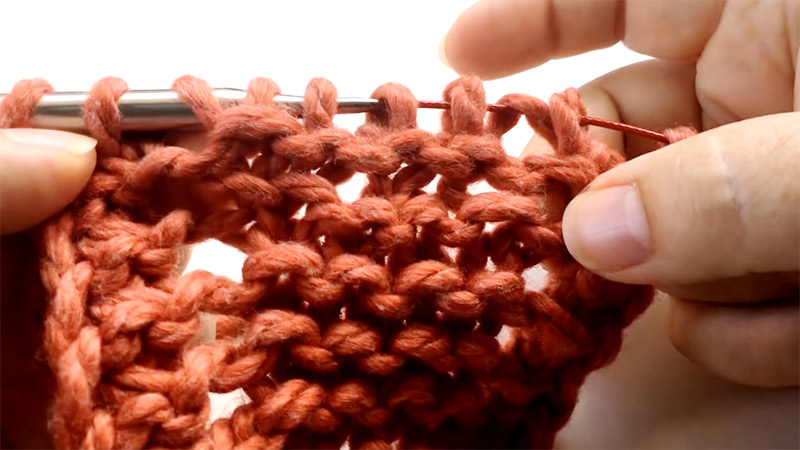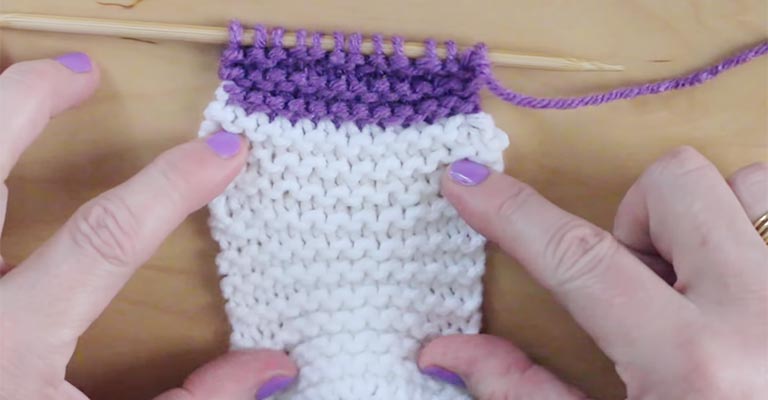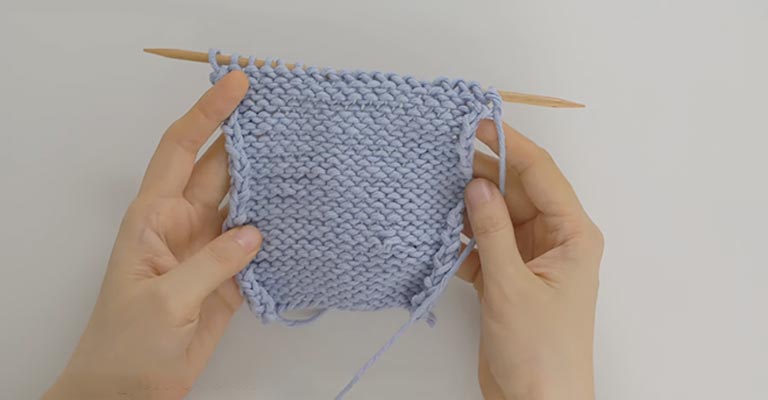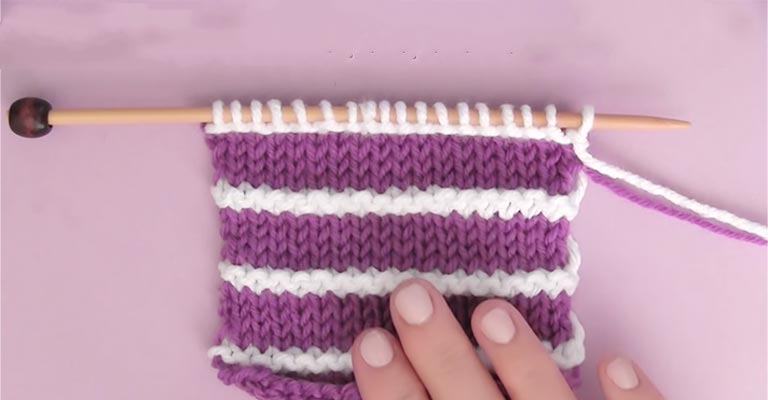In the world of knitting, the concept of the “wrong side” is an essential element that every knitter must understand. The wrong side in knitting refers to the side of a fabric that remains hidden within the completed project.
It is the side that won’t be on display, concealed on the interior. This often overlooked aspect of knitting plays a crucial role in determining the overall aesthetics and pattern consistency of the final piece.
Understanding how to identify the wrong side, with its distinct texture and characteristics, is fundamental to following knitting patterns accurately and achieving the intended look in a project.
In this exploration, we will delve deeper into what the wrong side means in knitting and why it matters.

What Is the Wrong Side In Knitting?
In knitting, the “wrong side” refers to the side of the fabric that remains hidden within the finished project. It typically showcases purl stitches, creating a textured, bumpy surface.
The wrong side differs from the “right side,” which features smoother, flatter knit stitches intended to be visible. Identifying the wrong side is crucial when following knitting patterns to ensure the intended appearance of the project.
Recognizing this distinction helps maintain pattern consistency, guarantees a polished final result, and is particularly important in reversible items like scarves and blankets.
By understanding the concept of the wrong side, knitters can achieve the desired texture and aesthetics in their creations.
How Do You Identify the Wrong Side in Knitting?
Identifying the wrong side of knitting is a fundamental skill for knitters, as it ensures that the finished project looks as intended.
The wrong side is the side of the fabric that won’t be visible when the item is complete. It typically displays purl stitches, which create a textured, bumpy surface.
Here are several methods to help you identify the wrong side of knitting:
Texture and Appearance
The most straightforward method is to examine the fabric’s texture and appearance. The wrong side often looks less uniform, with raised bumps or wavy lines, indicating the presence of purl stitches.
In contrast, the right side appears smoother due to the prevalence of knit stitches.
Pattern Instructions
Many knitting patterns specify which side should be the right side. Always refer to the pattern’s instructions to determine which side should be facing outward.
Visual Inspection
If your pattern doesn’t include specific instructions, visually inspect your work. The side with more texture and purl stitches is likely the wrong side, while the smoother, flatter side with knit stitches is the right side.
Stitch Markers
Some knitters use stitch markers, clips, or other markers to indicate the right side. Placing a marker on the right side can make it more visible and prevent confusion.
Row Count
Keeping track of your rows can also help you identify the right side. Some patterns may instruct you to start or end a certain stitch pattern on the right side.
Why Is It Important to Recognize the Wrong Side in Knitting?

Recognizing the wrong side in knitting is an essential skill with far-reaching implications for the quality and appearance of your knitted projects.
Here’s why it’s crucial to identify and distinguish the wrong side from the right side in knitting:
Aesthetics
Knitting patterns often specify which side should be the right side, the side intended to be visible in the finished project. By correctly identifying the wrong side, you ensure that the intended, smoother side faces outward.
This attention to detail contributes to a more polished and visually appealing final product.
Consistency
Maintaining the correct orientation of the right and wrong sides throughout a project is essential for achieving pattern consistency. This is particularly critical in intricate or textured patterns where the wrong side may differ significantly from the right side.
Ensuring consistency in the appearance of your knitting is key to achieving the intended design.
Professional Finish
Understanding and recognizing the wrong side of your knitting adds a level of professionalism to your work. A project with a well-defined right side and wrong side appears more polished and refined, which can make a substantial difference in the overall quality of the item.
Reversible Projects
In projects where both sides of the fabric are visible, such as scarves or blankets, accurately identifying the wrong side is crucial. It ensures that the pattern or design is preserved on both sides, allowing the item to be fully reversible and versatile in its use.
Mistake Avoidance
Recognizing the wrong side helps prevent common knitting mistakes. Inadvertently working on the wrong side can disrupt the pattern and lead to inconsistencies or unexpected outcomes. By staying mindful of the right and wrong sides, you minimize the risk of errors.
What Is the Difference Between the Wrong Side and Right Side in Knitting?

The difference between the wrong side and right side in knitting is primarily in their appearance and the stitches used.
Here’s a concise summary of the distinctions:
Appearance
- Wrong Side: The wrong side typically appears textured and may have raised bumps or wavy lines. This texture is due to the prevalence of purl stitches on this side.
- Right Side: In contrast, the right side has a smoother, flatter appearance, thanks to the dominance of knit stitches, which create a more uniform and even surface.
Stitches
- Wrong Side: The wrong side primarily features purl stitches, which have a textured appearance.
- Right Side: The right side is characterized by knit stitches, which lie flat and contribute to a smoother appearance.
Pattern and Color
- Wrong Side: If your knitting project includes color changes or patterns, they may appear more subdued or reversed on the wrong side.
- Right Side: On the right side, color changes and patterns are designed to be seen as intended, making them more vibrant and prominent.
Texture
- Wrong Side: The wrong side often has a textured feel when touched. It may feel slightly rough or bumpy due to the purl stitches, which create a raised surface.
- Right Side: On the right side, the texture is smoother and flatter. The knit stitches lie flat against the fabric, providing a more even and polished texture.
Direction of Stitches
- Wrong Side: Purl stitches on the wrong side are worked with the yarn in front of the work and are created by pulling the yarn through the existing loop from right to left. This results in a different direction of stitches.
- Right Side: Knit stitches on the right side are worked with the yarn in the back and are created by pulling the yarn through the existing loop from left to right. This creates a different stitch orientation compared to purl stitches.
What Types of Knitting Projects Require Identifying the Wrong Side for Success?

Identifying the wrong side of knitting is crucial for the success of various knitting projects. Here are some types of knitting projects where recognizing the wrong side is essential:
Reversible Items
Projects like scarves, shawls, and blankets that are intended to be used on both sides rely on recognizing the wrong side. This ensures that the pattern or texture looks good from every angle.
Lace Knitting
Lace patterns often have intricate designs that require precision. Recognizing the wrong side is crucial for maintaining the delicate and openwork appearance of lace on the right side.
Colorwork Projects
Knitting projects that involve multiple colors, such as Fair Isle or intarsia, necessitate identifying the wrong side. This is important to keep the color patterns consistent and aligned with the design.
Textured Stitch Patterns
Patterns with textured or cabled stitches may have distinct appearances on the right and wrong sides. Recognizing the wrong side is essential to ensure that the texture maintains its intended look.
Garments
Sweaters, cardigans, and other garments require accurate identification of the wrong side to shape the garment correctly and follow pattern instructions as intended.
Double-Sided Accessories
Accessories like mittens or slippers often have two wearable sides. Recognizing the wrong side is vital to achieving symmetry and maintaining pattern consistency on both sides.
FAQs
What does it mean when the knitting pattern says the wrong side?
When a knitting pattern says “wrong side,” it refers to the side of the fabric that should be hidden or not visible when the project is complete.
Can the wrong side ever be intentionally used in a knitting project?
Yes, in some cases, the wrong side can be used deliberately for design purposes. Reversible patterns, like those for scarves and shawls, may showcase both sides of the fabric, making the wrong side equally important in the design.
Do all knitting patterns explicitly mention the right side and the wrong side?
No, not all patterns specify the right and wrong sides. It’s essential to familiarize yourself with identifying them independently, as doing so can help maintain pattern consistency even when it’s not explicitly stated.
Are there any tools or accessories that can aid in identifying the wrong side?
Some knitters use stitch markers or clips to mark the right side, making it more visible during the knitting process. This can be particularly helpful in complex patterns.
What happens if I accidentally work on the wrong side of my knitting project?
Working on the wrong side when the pattern calls for the right side can disrupt the pattern and result in inconsistencies. You may need to unravel and redo the affected rows to correct the mistake.
To Recap
Grasping the concept of the wrong side of knitting is far from a trivial matter. It is a fundamental skill that knitters of all levels must master to create high-quality, visually pleasing projects.
The wrong side, with its textured surface and purl stitches, stands in contrast to the smoother, more uniform right side.
Recognizing and distinguishing between these sides is pivotal for maintaining pattern consistency and achieving the intended aesthetics. It adds a touch of professionalism to the final product, enhancing its overall quality.
Whether you’re crafting intricate lacework, cozy scarves, or versatile blankets, the ability to identify and utilize the wrong side ensures that your knitting projects meet the high standards of craftsmanship and design you’ve set for yourself.
Leave a Reply